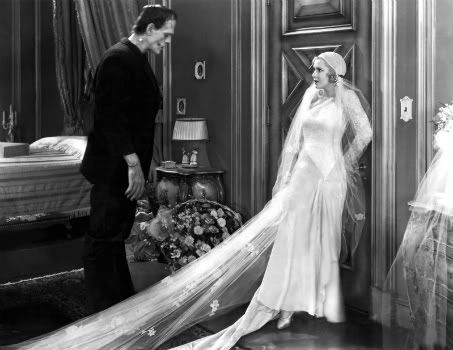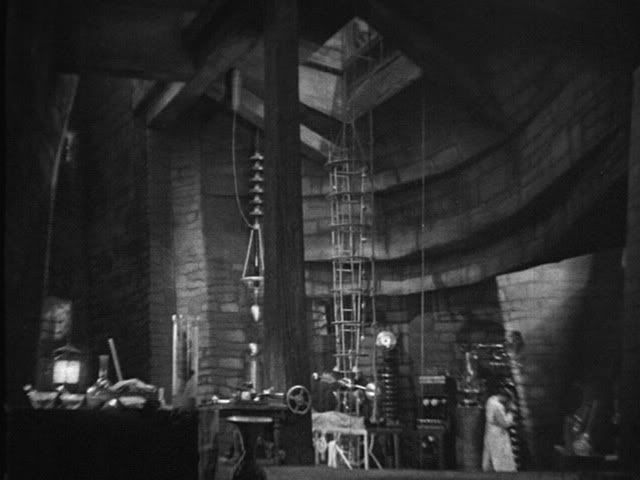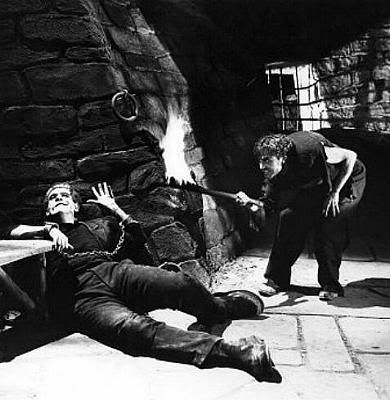Frankenstein
1931
Director: James Whale
Starring: Boris Karloff, Colin Clive, Mae Clarke
Frankenstein is not a film I’m totally in love with. It’s a little slow in parts, underdeveloped, and downright laughable in others. However, I think it’s worthwhile revisiting some of the true granddaddies of the horror genre, and that’s where Frankenstein is a very very special film. Many of the iconic traditions of horror are established in this movie, and the Monster… oh, the Monster is just amazing.
Essentially throwing out Mary Shelley’s original novel and only using cherry-picked parts, the somewhat stodgy plot focuses on mad scientist Henry Frankenstein (Clive) who creates Monster (Karloff) despite vapid and uninteresting fiancée’s objections (Clarke). Clocking in at a brisk 71 minutes, the film reminds you that it was still made during the nascent Sound Era; there were quite a few kinks yet to be worked out. The plot jumps in with absolutely no explanation, which, while I’ll agree that exposition is not always necessary, feels a bit shallow here.
Where the movie shines is in its two central performances – Clive’s mad scientist and Karloff’s Monster. The two of them jump off the screen in complete, insane, over the top embodiment of their roles. Clive plays the mad scientist with the zeal of an insane asylum patient, too wild and caught in his own helter-skelter world to see reason. His cries of “It’s alive! It’s alive!!!” make every clip reel of Hollywood history ever assembled. And then there’s Karloff – where to even begin! Karloff’s Monster has entered into public consciousness in a way that few other characters ever have. Manufacturers still sell masks of his heavy-browed, flat-top monster every Halloween en masse. This and Bela Lugosi’s Dracula (also making his debut in 1931) are the two most iconic Movie Monsters ever made.
The brilliance of the script and Karloff’s performance (and, indeed, Shelley’s original work) is that the Monster is not really a Monster. Karloff portrays his Monster as a child; scared, lonely, and ignorant, he comes into the world already hated by so many around him. How would you expect a child to respond if you continually beat it or kick it or taunt it with flame? Eventually, the child will fight back, except that this child also has brute strength on his side. The real “monsters” in the film are those who look on the monster as something to be beaten down, or dissected apart for study. In the climax of the film, a mob of angry villagers wielding pitchforks and torches (done thousands of times after, but here we see it for the first time!) is chasing down the monster in the hills. It is abundantly clear that the real horror of the scene comes not from the scared and hysterical monster lashing out at his mad scientist creator, but from the fanatical and crazed mob that has completely thrown out any semblance of traditional justice in favor of quick violence. The final scenes of the monster, holed up in a burning windmill with no way out, are pathetic and heart-rending – his fear of fire, his lack of escape, he cries out with high-pitched shrills of pure terror. This is a moving and very very sad scene, all down to Karloff.
Apart from Clive and Karloff, the rest of the cast is essentially expendable. Clarke is beautiful, to be sure, and I will admit that her gorgeous early 1930’s wardrobe is a fascinating juxtaposition to the traditional horror film trappings of dank cellars, old cemeteries, and abandoned buildings. A note should be made about the poorly placed character of Henry Frankenstein’s uncle, Baron Frankenstein, played by Frederick Kerr. Clearly intended as comic relief, the Baron is blustering and complaining, a kind of a Modern Major General that inexplicably turns up in a horror film. The character completely took me out the film; while I understand the need in a horror movie to lighten the mood every now and then, you needn’t do so through buffoonery. Ah well, I guess it adds to the dated charm of the overall film.
 |
| Wow, what a gown! |
The photography, while not exactly groundbreaking, is interesting. Showing heavy influences of German Expressionism, windows and shadows are exaggerated and there are several canted angle shots. When Frankenstein confronts his Monster at the end of the film, they are both beautifully backlit against a painted cloud screen. It certainly adds to the overall effect of the film.
Overall, Frankenstein is a dated film. It certainly won’t creep you out or frighten you, not if you have any modern film sensibilities at all. However, there is reason that the film is remembered and cited as often as it is. Karloff’s monster is unforgettable, and the images put to screen here have inspired filmmakers ever since. It deserves to be seen.
Arbitrary Rating: 6/10




I don't even remember the Uncle character, so I must have blocked him out. I completely agree that this is Karloff's film. His performance as the Monster is truly moving. I did see this film only after seeing Young Frankenstein a couple of times so it did color my viewing of it. On the other hand, I now got even more jokes that were in Young Frankenstein.
ReplyDeleteIt's a good thing you blocked the uncle out. He's ridiculous.
DeleteI adore Young Frankenstein - easily my favorite Mel Brooks. EASILY.
To really get everything in Young Frankenstein, you need to also see Bride of Frankenstein--the entire sequence with Gene Hackman, for instance, comes from the sequel.
ReplyDeleteI'll join the chorus of those putting this film right at the feet of Karloff. He made this film what it is, and there's no other reason needed to see it than his very human and real performance.
I'll join with Chip in saying that I don't remember the uncle, either. Evidently, I've blocked him completely.
I think Bride of Frankenstein is better than the original, but Young Frankenstein is even BETTER than both of them.
DeleteSee, there's a reason you two have blocked out the uncle - TRUST ME.
Karloff is so good in this movie. Completely elevates the film.
I am perfectly in line with you here. I am not overly fond of the movie as such, early horror movies are just not really scary, but it is also incredibly iconic and certainly a step up from the other horror movies of the age (Dracula and King Kong). The winning point of the movie is the ambience created by the photography. It works perfectly!
ReplyDeleteYeah, the photography is very good. I agree that this is better than Dracula, but I disagree that it's better than King Kong. I found the story in King Kong very affecting, and I got very invested in the film.
DeleteIt's hard for a really early horror movie to still be scary today. Atmospheric and iconic, yes; scary? No.
golden goose sneakers
ReplyDeletehermes handbags
louboutin shoes
air jordan
kd 12 shoes
converse
adidas nmd
chrome hearts outlet
lebron 17
golden goose outlet
this link Full Article read the full info here Look At This click to investigate visite site
ReplyDeletewwhc993knx
ReplyDeletegolden goose outlet
golden goose outlet
golden goose outlet
golden goose outlet
golden goose outlet
golden goose outlet
golden goose outlet
golden goose outlet
supreme outlet
golden goose outlet